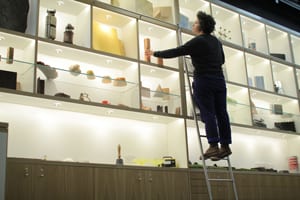Wooden bathrooms, golden spoons and other tales of materials in society
By Clare S Ryan, on 15 March 2013
This morning, crawling out of my bed in icy south London my first post-sleep experience was of a chilly, tiled bathroom.
Sullenly brushing my teeth with my feet on the cold floor, new questions popped into my head. Are cold tiles really the best material to clad the bathroom in? Who made these tiles in the first place? What are they made of?
Before attending Professor Mark Miodownik’s Lunch Hour Lecture ‘Stuff matters’ these were not questions that routinely entered my head – the appearance of my first coffee was a much more pressing matter.
But Mark’s view of the world is perhaps different to most people’s, and it probably explains why he is the UCL Professor of Materials & Society (note the ‘society’ part) and we are not.
Materials and Society
If you look around you now you will see a lot of materials that once started out as rocks, sludge and various non-identifiable living things. Take, for example, the plastic of your keyboard, the water glass on your table, the concrete on the pavement outside or a stainless steel fork that you ate your lunch with (perhaps that last one’s just me).
Where did all these materials come from? Who made them? If you’d have asked Mark 10 years ago, he would have said – perhaps with a hint of pride – that material scientists made them.
But, candidly, it turns out that this isn’t really the whole truth. Material scientists (like most academics) make academic papers, and not stuff in the real world at all.
Most of the things you can see around you are the result of more than 5,000 years of development in a process that reflects the evolution of society itself.
The history of glass
Not convinced? Take the history of glass. The ancient Egyptians revered glass and were the first to make statues and art from it.
The Romans developed the technology one step further, understanding the importance of things like the purity of the quartz needed, and how it could be blown. This resulted in the first glass windows and drinking vessels.
Voila. The glass of wine was created and being able to look at the colour of your tipple has changed the lives of people as diverse as Julius Caesar and Bridget Jones ever since.
Later on glass technology moved east with the supreme glazing skills of Chinese ceramics makers, who were able to control minutely the bubble and crystal sizes of the cooling glass to decorate their china.
Galileo took glass yet a step further. Up until then, it had been something aesthetic rather than practical. By commissioning lenses that he could look at the sky with, Galileo produced the first evidence of our solar system and paved the way for microscope techniques.
Later still, in the 1950s, an English company called Pilkington invented a method of casting glass on atomically-smooth molten metal – allowing for the production of large plates and dramatically changing the future of architecture.
The Institute of Making
So once you really start considering a material and its history all sorts of questions start cropping up. Where did it come from? Who made it? What does it do? What could it do?
It might take more than just a material scientist to explore those questions fully and reach around the dimensions of the subject.
He realised that what he needed first was a place where he could really consider objects – by being able to hold them and letting other people hold them – and a place where people could come together to start making things.
He gradually recruited a team of designers, artists, physicists, engineers, and even a jeweller and a dancer to join him in his making quest.
The beginnings of the Materials Library emerged and, later on, with the vision of UCL Engineering (and their Dean), the Makespace and the entire Institute of Making was given a new home at UCL.
One of their projects, lead by Mark and Zoe Laughlin, co-director of the Institute of Making, was a set of spoons made of different materials.
They studied what the spoons tasted of – so, whether a zinc spoon tastes different to a copper one – and whether the spoon made the food taste differently.
The work was published, but the team wanted to go one step further and take their research out of an academic setting.
They approached the chef Heston Blumenthal and food scientist Harold McGee to create a meal and see which spoons worked best for which food (hint: a curry tastes better with a zinc spoon!).
It’s this experimenting with materials in society that lies at the heart of the brand new Institute of Making at UCL. Materials are necessarily part of society and culture – we are sensual beings and touch and feel the materials around us.
The Institute of Making is open to everyone at UCL, from a professor to a cleaner. Everyone knows about materials that they use and can influence the conversation about them. It’s also initially open to the public for one day every month.
I’m certainly thinking about the merits of a non-tiled bathroom (Mark’s is wooden if you’re curious). And I wonder what my yoghurt would taste like eaten from a golden spoon?
 Close
Close



